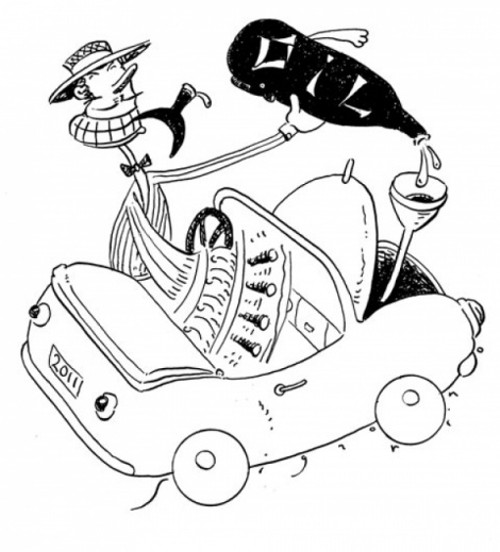A friend and I were watching a documentary on blue whales when he piped up, “You know, the Japs still hunt whales for their oil. They use it to lube new cars.” He went on about whale oil being superior to petroleum-based lubricants. I think he’s full of crap. Since I can’t find anything via Google to confirm or deny his claim, I must pester you for the answer. —Lot
“The Japs”? Where’d you dig this guy up, anyway? He’s only got part of the story, though. Let’s take it from the top.
Once upon a time whale oil was, in fact, used to lube new cars, in the United States as well as Japan. However, in the early 1970s it was banned from vehicles sold in the United States because of environmental concerns. Automatic transmissions immediately began failing all over, and some contend they’ve never been the same since—your only hope is to buy Jonah’s Miracle Whale Oil Substitute before it’s too late.
Should you take such a warning at face value? What a question. Have promoters of commercial products ever been known to lie? However, certain nuances have perhaps been glossed over.
We’ll start with whale oil. Surprising as it may seem coming from an industry that peaked circa 1850 due to the invention of kerosene, whale oil remained a commercially viable product for a long time—at one point it was used to make margarine. The automotive industry was especially fond of sperm oil, which is actually a liquid wax derived from sperm whales, because when combined with sulfur it made an excellent lubricant, remaining effective at high pressure and low temperature; it also inhibited rust. When the need for reliable automatic transmission fluid arose, use of sperm oil as a “friction modifier” was an obvious choice.
Unfortunately for sperm whales, the stuff worked too well. Partly as a result of demand from the auto industry, the huge mammals were hunted to the brink of extinction. In 1970, the United States declared sperm whales and seven other whale species endangered, meaning not only that Americans couldn’t hunt them but that whale-derived products could no longer be imported. Starting with the 1973 model year, U.S automakers switched to new whale-free automatic transmission fluids.
So what was the result? At least 5,500 automatic transmissions failed prematurely in cars built between 1973 and 1975. Corroding solder joints in the transmission cooling system allowed antifreeze and transmission fluid to mix, with unfortunate results. In news stories at the time, General Motors, maker of the cars with the defective trannies, blamed the problem on the lack of whale oil. The implication: it wasn’t the fault of GM, but rather those meddlesome conservationists.
If you read the news accounts carefully, however, you notice that it wasn’t GM automatic transmissions across the board that failed, but rather two specific types, the Turbo Hydra-matic 350 and 400 series gearboxes. The bad transmissions accounted for one-sixth of 1 percent of these units installed in GM vehicles at the time. We scoured the technical literature and the frequency-of-repair survey results in Consumer Reports for signs of an industrywide spike in automatic transmission failures in the mid-1970s. Nothing.
From this, we deduce that while the absence of whale oil perhaps didn’t help, the real issue was a defect in GM’s transmission design. Be that as it may, GM reformulated the solder and switched transmission fluids, and the problem went away.
However, you can still find people who think automatic transmissions just aren’t as reliable as they used to be back in the whale-oil days. As far as I can determine, this is bunk. In the early 1960s, for example, a typical GM automatic transmission might conk out at 25,000 to 40,000 miles; by the 1980s the norm was more like 100,000 miles. Truth is, industry found equal or better substitutes for just about every whale oil application, transmission fluid included.
Up till now we’ve been speaking of the United States. What about Japan? Since the Japanese have had other things on their minds lately, I figured I wouldn’t bug them about their transmission fluid ingredients. However, the International Whaling Commission says that from 1993 through 2009, the Japanese killed 47 sperm whales. During that time, Japanese automakers built 178 million vehicles. Assuming A. half had automatic transmissions, B. the average sperm whale yielded 30 barrels of oil, and C. all the oil went into transmission fluid (a sizable assumption), we’re looking at less than half a teaspoon of sperm oil per vehicle.
If your friend thinks that’s spreading things too thin, no problem. Tell him online vendors will be happy to sell him a supplement containing a “direct molecular replacement for sperm whale oil,” which he can then add to his transmission fluid. A 10-ounce bottle costs somewhere between $9 and $25, roughly the price of a decent pinot noir.
Send questions to Cecil via StraightDope.com or write him c/o Chicago Reader, 11 E. Illinois, Chicago 60611. Subscribe to the Straight Dope podcast at the iTunes Store.
More by Cecil Adams
-
This Is the End, My Friend
This week's Straight Dope marks the last appearance of the column as the Teeming Millions have known it for the past 45 years.
- Jul 11, 2018
-
Do Brain Supplements Do Anything?
Brain Drain
- Jul 4, 2018
-
Is flying really worse for the environment than driving?
Planes and Trains
- Jun 27, 2018
- More »




